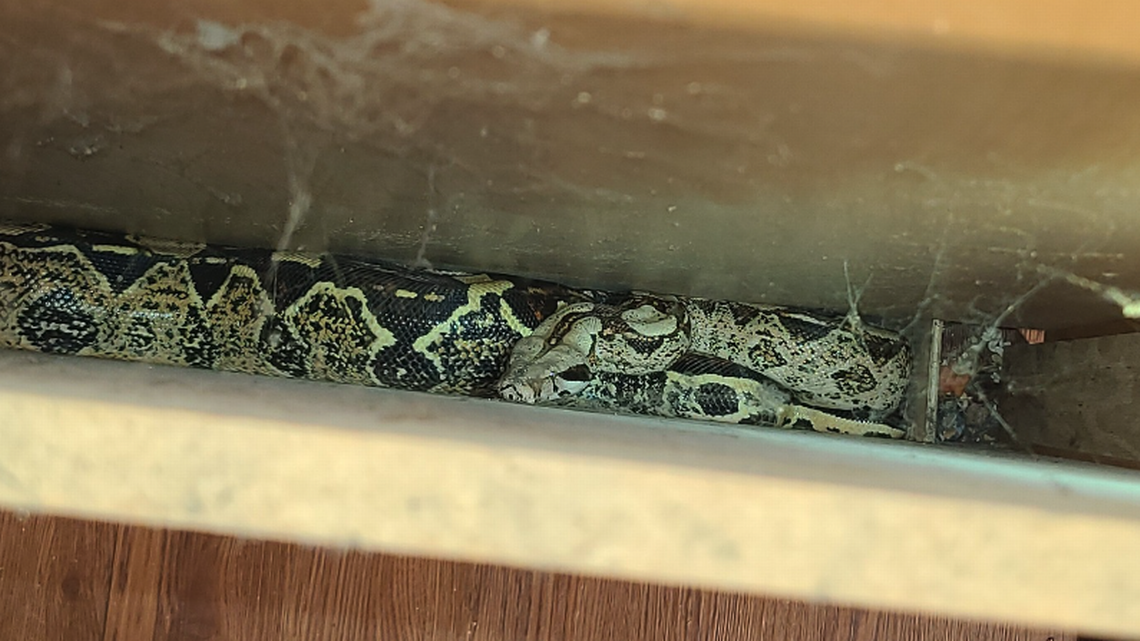16 ft Creature Slithers Across Trees: A Fascinating Discovery in the Animal Kingdom
In the vast realm of the animal kingdom, there are countless creatures that never cease to amaze us with their unique adaptations and behaviors. Recently, a remarkable discovery has captured the attention of scientists and nature enthusiasts alike. A 16 ft creature has been observed slithering across trees, defying our preconceived notions of how animals move through their environment. This extraordinary find has opened up new avenues for research and has left experts pondering the evolutionary significance of this peculiar behavior.
The Enigma Unveiled: Unraveling the Secrets of Tree Slithering
The first question that comes to mind is, what exactly is this creature? The 16 ft tree slitherer belongs to the genus Arborisquamata, a newly identified species that has yet to be officially named. Its elongated body, covered in smooth scales, allows it to effortlessly glide along tree trunks and branches. This adaptation is reminiscent of snakes, but unlike them, the tree slitherer possesses limbs. These limbs, although not as developed as those of other arboreal animals, serve as additional support during locomotion.
One might wonder why this creature has evolved such a unique way of moving. The prevailing theory among researchers is that tree slithering provides the creature with several advantages. Firstly, it allows for efficient movement through dense forest canopies, where traditional walking or running would be hindered. Secondly, by utilizing a serpentine motion, the tree slitherer can navigate through narrow gaps between branches with remarkable agility. This ability to access otherwise inaccessible areas grants it an advantage over other predators or competitors.
Adaptations for Arboreal Life: Anatomy and Behavior
To better understand the mechanics of tree slithering, it is essential to examine the creature’s anatomy. The limbs of the tree slitherer are elongated and possess sharp claws, which aid in gripping the bark of trees. These claws, combined with the creature’s muscular body, allow it to generate the necessary force to propel itself forward. Additionally, its scales are not only smooth but also possess a slight adhesive quality, further enhancing its grip on vertical surfaces.
Observations of the tree slitherer’s behavior have shed light on its unique adaptations. When moving along a tree trunk, the creature undulates its body in a wave-like motion, similar to that of a snake. This undulation, combined with the coordinated movement of its limbs, allows for a seamless transition from one branch to another. Furthermore, the tree slitherer has been observed using its tail as a stabilizer, providing balance and preventing it from falling off the trees.
Evolutionary Implications: Unraveling the Origins of Tree Slithering
The discovery of the tree slitherer raises intriguing questions about its evolutionary history. How did this adaptation come about? Did it evolve independently or is it a remnant of an ancestral trait? Scientists speculate that the tree slitherer’s unique locomotion may have evolved as a response to specific ecological pressures. By occupying a niche that other animals cannot access, it has likely reduced competition for resources and increased its chances of survival.
Comparative studies with other arboreal creatures, such as snakes and primates, may provide valuable insights into the evolution of tree slithering. By examining genetic similarities and differences, researchers hope to unravel the genetic basis of this adaptation. Additionally, further exploration of habitats where the tree slitherer is found could shed light on its ecological interactions and its role within the ecosystem.
Conservation Concerns: Protecting the Tree Slitherer’s Habitat
As with any newly discovered species, conservation efforts become a priority. The tree slitherer’s habitat, predominantly tropical rainforests, is under constant threat due to deforestation and habitat fragmentation. It is crucial to protect these ecosystems to ensure the survival of not only the tree slitherer but also the myriad of other species that call these forests home. By raising awareness about this remarkable creature, we can foster a sense of appreciation and promote conservation initiatives aimed at preserving its habitat.
Conclusion:
The discovery of the 16 ft tree slitherer has unveiled a fascinating adaptation in the animal kingdom. Its ability to slither across trees challenges our understanding of locomotion and highlights the incredible diversity of life on our planet. As scientists continue to study this enigmatic creature, we can look forward to unraveling more mysteries and gaining a deeper understanding of the intricate web of life that surrounds us.













Post Comment